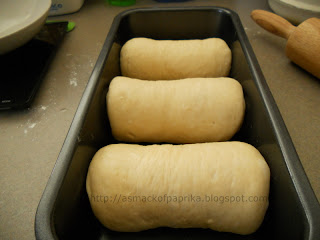We both love bread and I bake this one often. I have baked many different types of bread. Most of the bread drys up very quickly, even though I added potato flakes (some chefs says potatoes can keep the bread moist) and store them in an airtight container. Until one day I tried the Japanese Hokkaido Bread, which uses tongzhang/roax, (a mixture of water and flour which helps to keep the bread moist-see below), and I really like it. It keeps the bread moist longer and the texture softer, just the way I want it. Since I bake very often, I want to use ingredients that I always have on hand, like sour cream, butter, fresh milk... and I have created this recipe by using what I always have in my kitchen pantry. This recipe is for my niece, G who also loves bread like me.
3 1/2 cups bread flour (more for dusting)
2/4 cup potatoes flakes
 1/3 cup sugar
1/3 cup sugar
2 tsp milk powder (optional)
2 tsp instant yeast
1 egg, beaten
1/4 cup fresh milk (can replace with sour cream)
1/4 cup sour cream
All of the tongzhang/roax
(Tongzhang recipe is below)
3 tbsp unsalted butter, melted
1 full tsp salt
A non stick 5" x 11" bread pan
Method of cooking thonzhang/roax:
1 cup water or fresh milk
1/3 cup all purpose flour
 In a small saucepan, whisk together water and all purpose flour. Whisk until well combined and cook on a stove on medium heat, stirring from time to time until the temperature reaches 150°F. Remove from heat, cover with lid and leave to cool.
In a small saucepan, whisk together water and all purpose flour. Whisk until well combined and cook on a stove on medium heat, stirring from time to time until the temperature reaches 150°F. Remove from heat, cover with lid and leave to cool.
Note: You have to stir more frequently towards the end to avoid the bottom getting burned.
Method of making bread :
Set bread machine on dough function. Placed all wet ingredients into
the bread pan: egg, fresh milk, sour cream, butter and
thonzhang/roax, follow with the dry ingredients except salt:
bread flour, potato flakes, sugar and milk powder. Make a small
well in the middle of the flour and add yeast, lastly place salt at one corner
of the pan and press start.
Note:
Salt is placed at one corner because it affects the reaction of the yeast. I have learned the hard way. I added the salt too close or together with the yeast, the dough either did not rise or rose very little. Imagine eating a no-yeast bread!!!
Use less liquid in Summer and more in Winter. I always check the dough after 4 to 5 minutes of kneading. If the dough does not stick to your fingers, it is too dry, so add more milk or water, 1 tbsp at a time. If it is too sticky add more flour, also 1 tbsp at a time.

The dough should be sticky when it is ready (about an hour), dust counter top with a little flour, remove the dough from the bread pan, divide into 3 portions and roll the dough into balls by hand. (see picture on the right)
Use a roller pin and roll the dough into a rectangular shape. (see picture
on the left)
Roll up the dough from one end to the other (see picture on the left below), use your fingers to pinch the end of the dough together and place into the bread pan with seam side down.
 Let rest for an hour or until the dough rises to double the original size. (See picture on the right below)
Let rest for an hour or until the dough rises to double the original size. (See picture on the right below)

Preheat oven to 350 °F and bake for 30 minutes or until the food kitchen thermometer reaches 160°F. Remove from the bread pan and let cool. Serve warm or cool.